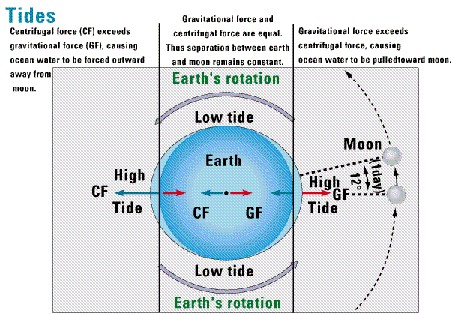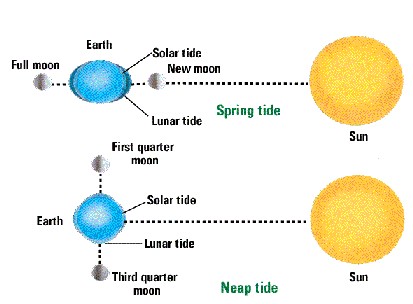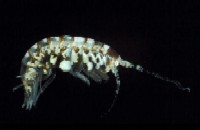- Substrate: macroalga and periphyton live attached and non-motile on substrate; substrates can be rocks, corals, sand, other algae, aquatic animals
- Light requirements for photosynthesis limits distribution to shallow, coastal areas
- Macroalgal production is important for coastal food webs in terms of carbon fixation and as habitat for other animals and juvenile fish; production of seaweed communities and kelp forrests is a high as highest terrestrial primary production
- Only 10% of macroalgal biomass is directly grazed by herbivores, 90% is made available to higher trophic levels by the detritus food web
- In streams and shallow lakes, periphyton contributes more primary production than phytoplankton
- Eutrophication can lead to overgrow of substrates and benthic communities by fast-growing macroalgae such as the green alga Cladophora
- Community shaping factors: herbivorous grazing, competition for substrate and nutrients, pathogene attack, physico-chemical environment
- Tides : periodical changes in the water level due to the gravitational influence of the moon (and the sun)
- High tides occur every 12 hrs 25 min = ½ lunar day !
- Sun and Moon and Earth…
- Lunar tides occur twice a day (semidiurnal tides), solar tides once a day (diurnal tides)
- Depending on the orbital position of sun and moon and ocean region, mixed tides occur.


Gravitational forces of sun and moon add at full and new moon to produce spring tides. Gravitational forces of sun and moon compete at half moon to produce neap tides.


- Harsh environment: loss of water at low tide; physical forces of waves; variation in temperature; UV radiation; ice formation; variation in salinity (rain exposure)
- Adaptation of algae to life between water and air:
- Solid attachement against wave action
- High temperature and water loss tolerance (60-90% in some algae)
- Synchronized release of gametes
- Cluster formation
- Highly flexible thalli or thick, rigid thalli
- Littoral zonation: Tides set the boundaries for permanently, periodically, and rarely submerged zones in the coastal ecosystem, the littoral
- Eulittoral: range between mean low water and mean high water, periodically submerged
- Supralittoral: range above the mean high water, rarely submerged
- Sublittoral: range below the mean low water, permanently submerged
- Zonatation of macroalgae according to resistance to wave action, falling dry, light requirements – specific for each coast and substrate
- Wave action has positive and negative effects:
- Reduce shading by re-arranging thalli
- Transport and mixing of nutrients
- Reduce thickness of boundary layer (higher uptake of nutrients and faster growth)
- Remove sessile animals and other competitors for habitat
- Dispersal of spores, gametes, zygotes
- Damage, destruction, removal of thalli
- Removal of settling zygotes/germlings
- Expense of energy into strong holdfast and thick, rigid thallus or calcification
- Destruction by ice floes during winter in temperate and polar regions
- Light: High light irradiance and UV irradiation can cause photoinhibition and DNA damage; low light irradiance requires low-light adaptation by higher pigment concentrations and adjusting thallus forms
- Light and UV protection mechanisms involve inactive photosystems, increase in accessory pigments, UV absorbants (mycosporin like amino acids)
- Timing of growth and reproduction is triggered by light signals (sensor pigments cytochrome, phytochrome)
- Herbivory Defense
- Macroalgal herbivores are predominantly amphipods, copepods, polychaetes, urchins, fish
- Chemical defense by production of secondary metabolic substances such as terpenes, alkaloids, halogenated (bromid) phenolics, and many more
- One species can produce multiple defense chemicals
- Structural defense by spiny or calcified thalli
- Interaction of defense mechanisms: in the green alga Halimeda, cell division occurs at night (no visual predators), and young, less calcified cells contain more defense chemicals than older, calcified cells
-
Animals
(e.g. the amphipod Ampithoe) ingest algal defense chemicals to protect
themselves against grazers

The amphipod Ampithoe uses defense chemicals from the brown alga Dictyota - Energetic cost: production on complex defense molecules requires energy; defended species often grow slower than species without defense chemicals; production of defense chemicals can be grazer-induced or constitutive (continuous)
- Marine Periphyton Turfs
- Periphyton compete for habitat space
- Macroalgae possess mechanisms to prevent overgrowth by periphyton, such as shedding superficial cell layers or constant errosion of thallus tips
- Turf development starts usually with diatom settlement, followed by cyanobacteria, which eventually dominate most marine turfs
- epiphytic cyanobacteria are a major source for nitrogen fixation
- Primary production is high per unit biomass (in contrast to macroalgae)
- Grazing pressure on epiphyton is higher than on macroalgae; grazing helps preserving the turf by preventing dominance of larger forms and enhancing branching by grazing on filament/thallus tips
- Freshwater Periphyton
- Freshwater periphyton comprises settlement on other algae/plants and microphytobenthos (on rocks and sediments)
- Major source of photosynthetic carbon fixation in shallow lakes and streams, which do not provide a favorable environment for plankton
- Periphyton traps nutrients from the water and transfers them to the sediment upon death, thus preventing nutrient loss from wetlands and streams into lakes
- Freshwater periphyton contains more bacteria and fungi than marine turfs, held together by mucilage from algae and/or bacteria
- Metaphyton describes loose masses of epiphyton broken from their substrate and floating in the plankton
| Positive
Effects
|
Negative
Effects
|
Grazing losses are higher than in marine epiphyton